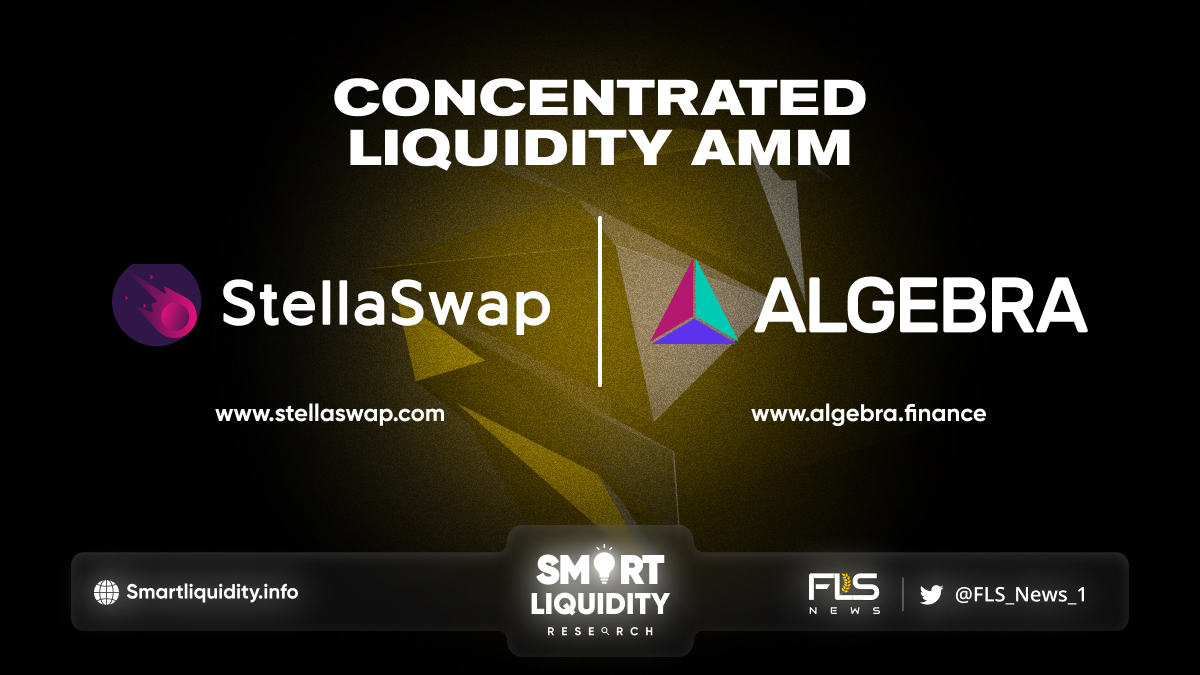StellaSwap Partners With Algebra


StellaSwap Partners with Algebra to Bring Concentrated Liquidity To Polkadot & Moonbeam
StellaSwap partners with Algebra to launch a capital-efficient DEX called ‘Pulsar’, which represents a ground-breaking enhancement to StellaSwap’s current hybrid DEX, utilizing the power of concentrated liquidity to provide a much more efficient way of trading and earning as before. With Pulsar, users will access optimal asset prices, low-slippage and greater yield optimization for LP stakers!
Concentrated Liquidity is the Future
Spearheaded by Uniswap’s V3 AMM model, concentrated liquidity has proven to be the most efficient DEX model so far. This year alone, numerous (prominent) DEXs have signaled their intentions to launch a concentrated liquidity model. Orca of Solana, Trader Joe of Avalanche and Quickswap of Polygon, just to name the top brass.
While StellaSwap predicated on a hybrid model of a standard AMM (constant product model) and stable AMM (constant product + constant sum model), it isn’t capital efficient and suffers from high-slippage. This means higher cost of trading to end-users. Additionally, we see an extremely low liquidity utilization rates, ranging from an average of between 5%-10%. This means that for every $10 million of TVL on StellaSwap, only $500k or $1 million trading volume (daily) emanates from the pool, thereby limiting yields for liquidity providers due to a large percentage of ‘unused’ capital. Hence, inefficient.
With Pulsar, they’ll allow liquidity providers (LPs) to ‘concentrate’ their liquidity in specific price ranges to maximize capital efficiency. LPs who provide deeper liquidity for ranges where trades actually occur will earn a higher share of fees and rewards, thereby enhancing potential ROIs.
Here’s a quick summary of how concentrated liquidity is a beast of AMMs;
- LPs can provide liquidity with up to 4,000x capital efficiency relative to standard AMMs, earning higher ROIs on their capital
- Liquidity utilization rates beyond 100%, compared to an average of 5%-10% that StellaSwap currently has. This is good news for LPs as they’ll earn more fees for a given capital base
- Capital efficiency results in ultra-low slippage trade execution that can surpass both centralized exchanges and stable AMMs
- LPs can significantly increase their exposure to preferred assets and reduce their downside risk
- LPs can sell one asset for another by adding liquidity to a price range entirely above or below the market price, approximating a fee-earning limit order that executes along a smooth curve️
- With greater ROI potential, STELLA emissions can be exponentially reduced. With a reduced inflation rate, we’ll be on the path of tokenholder-value maximization
Building Pulsar with Algebra
In order to realize the vision for Pulsar, StellaSwap has officially acquired the license for a variation of concentrated liquidity AMM from Algebra, the superstar team that has developed the V3 codebase. Algebra is behind the launch of Quickswap’s concentrated liquidity AMM (largest DEX on Polygon) that recently launched. They have finalized the agreement with Algebra, which would grant them exclusive usage of the concentrated liquidity codebase on Moonbeam.
One of the key proposition of Algebra in creating a more ‘user-friendly’ solution, relative to Uniswap, is their dynamic fee model. Though groundbreaking, Uniswap’s V3 had an Achilles heel; close to 50% of LPs on Uniswap’s V3 lost money due to impermanent loss. With Algebra’s dynamic fee model, yield optimization is inherent in the staking process. This mean users do not need to to actively move their liquidity between pools to earn the highest rewards.
Audits
There can be no doubt that security is the most important thing for StellaSwap, especially after what transpired with Nomad’s exploit. There can be no compromises when it comes to security. Its their responsibility to ensure that all security issues are address before launching. Algebra’s codebase has undergone two external audits, from Hexen and ABDK (Uniswap’s auditor). All critical and major issues have been addressed by Algebra. The audit will be shared with the community soon.
What Can We Expect?
They’re currently hard at work developing Pulsar, and we hope to launch it around the end of September/early October period. This is a huge launch for StellaSwap and we need to ensure that we have a comprehensive sweep across all vectors, from development to content collaterals to facilitate easy onboarding into Pulsar.
Dynamic Fees
A key question from the community would be the fee structure for users. Compared to StellaSwap’s previous standard AMM fees of 0.25%, Pulsar will follow a variable fee structure that is dependent on core factors such as volatility. For instance, the fee tier for exotic pairs could be as high as 1% while that of a stablepool could be 0.01%. However, it is expected that the average swap fee on StellaSwap would range anywhere from 0.1% to 0.15%. More information on the fee tiers would be explicated down the line.
Protocol Revenue Breakdown
Regardless of the variable fee structure of Pulsar, the structure for StellaSwap’s revenue breakdown based on expected distribution would be as such;
- LP Stakers: 78%
- xSTELLA holders: 12%
- Treasury: 8.5%
- V3 Devs: 1.5%
In order for StellaSwap to maximize tokenholder value, they will need to incentivize xSTELLA holders in order to strengthen value-accrual of STELLA token, as it represents an integral component of StellaSwap’s protocol.
Strengthening Moonbeam & Polkadot Ecosystem
A core vision of StellaSwap is to be the Schelling point of Polkadot, actualized via cross-consensus message format (XCM). For that to materialize, it is necessary for us to evolve past standard AMMs and launch an extremely capital-efficient DEX.
Not only that, the recent exploits of Nomad bridge and Acala’s aUSD has resulted in a less-than-ideal sentiment across the entire ecosystem, with aggregate TVL being at an all-time low. They are confident that things will pick up, albeit at a slower pace. That is why as the leading DEX on Moonbeam. It is vital for us to create a stronger foundation that will benefit the ecosystem.
In general here are the high-level benefits that will accrue to the ecosystem;
- Maximize Ecosystem Liquidity Utilization: The aforementioned exploits has resulted in dampening of TVL from value depegging and capital leakage.
- Enable Sufficient Liquidity for Stakeholder Operations: Optimal capital efficiency results in requiring a fraction of TVL to achieve low slippage levels and better price discovery, which is vital for relevant stakeholders like money market protocols on Moonbeam — such as Moonwell — to facilitate liquidations.
- Effective Emissions Management for Ecosystem: Perhaps a core element for the long-term sustainability of any ecosystem is effective emissions management, especially in the midst of token inflation to achieve protocol bootstrapping (i.e. attracting liquidity).
- Improved User Experience: Users would be ecstatic to know that with Pulsar, price discovery for token value would be the most optimal and there’ll be ultra-low slippage, thereby resulting in tremendous cost-savings.
About StellaSwap
StellaSwap the first and leading Moonbeam DEX that offers an integrated gateway to the DeFi world. Users can swap, earn, yield farm, bridge assets, explore new projects & engage in NFT trading all from a single unified platform.
About Algebra
ALGEBRA a decentralized exchange with adaptive fees, built-in farming and more with support for deflationary tokens. The new DEX is a multi-purpose solution that works with existing DeFi instruments and provides its users the maximum functionality of all similar services on the market.




